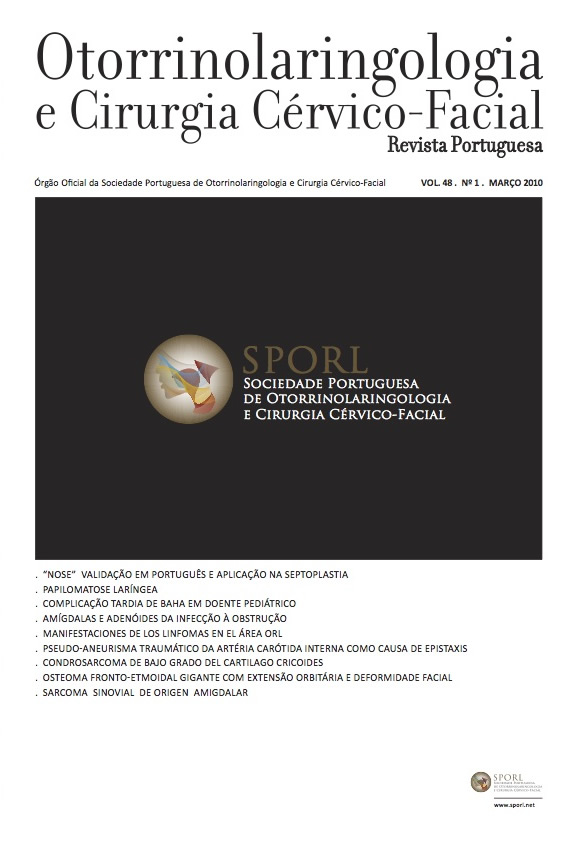Laryngeal papillomatosis - casuistry of IPOFG-EPE - Porto
DOI:
https://doi.org/10.34631/sporl.257Keywords:
larynx, papilloma, human papillomavirus, squamous cell carcinomaAbstract
Papillomas are the most common benign tumours of larynx. Children and adults can be both affected. The infection by human papillomavirus virus is responsible for the development of laryngeal recurrent papillomatosis. The treatment consists of surgical removal of the lesions, although the recurrence rate is high. Some cases of malignant transformation of papilomas are described.
In the present article we present a retrospective analysis of a period of 16 years, relative to the occurrence of laryngeal papillomatosis in an oncologic ENT department. The incidence of this pathology comparatively to the cases of larynx carcinomas appeared in the same period of time is also approached. The coexistence/evolution of the forms of adult laryngeal papillomatosis to squamous cell carcinoma was investigated. Although this department isn't specifically directed to observe children, we also report some cases of children treated during this interval of time.
Downloads
References
Green GE, Bauman M, Smith RJH. Pathogenesis and treatment of ju- venile onset recurrent respiratory papillomatosis. Otolaryngol Clin North Am 2000;33(1):187-207.
Hasan S, Dutt SN, Kini U, Shariff S et al. Laryngeal carcinoma ex- papilloma in a non-irradiated, non-smoking patient: a clinical record and review of the literature. J Laryngol Otol 1995;109:762-766.
Reeves WC, Ruparella SS, Swanson KI, Derkay CS et al. National re- gistry for juvenile-onset recurrent respiratory papillomatosis Arch Otolaryngol Head Neck Surg 2003;129:976 -982.
Sakakura A, Yamamoto Y, Takasaki T, Makimoto K et al. Recurrent laryngeal papillomatosis developing into laryngeal carcinoma with human papilloma virus (HPV) type 18: a case report. J Larygol Otolo 1996;110:75-77.
Velyvyte D, Laiskonis A, Virgilijus Uloza, Godzicka-Josefiak A. Pre- valence of human papillomavirus infection among patients with laryngeal papillomatosis and the influence of some risk factors on the persistence of papillomaviruses in the upper respiratory tract. Medicina 2002;38(5):83-88.
Wiatrak BJ, Wiatrak DW, Broker TR, Lewis L. Recurrent respiratory papillomatosis: a longitudinal study comparing severity associated with human papilloma viral types 6 and 11 and other risk factors in a large pediatric population. Laryngoscope. 2004;Suppl 114: 1-23.
DeVita VT, Hellman S, Rosenberg SA. Cancer Principles & Practice of Oncology 6th Edition. Lippincot, Williams & Wilkins.2001.
Major T, Szarka K, Sziklai I, Gergely L et al. The characteristics of human papillomavirus DNA in head and neck cancers and papillomas.J Clin Pathol 2005; 58: 51-55.
Damjanov I, Linder J. Anderson's Pathology. 10th edition (vol 1). Mosby 1996.
Gerein V, Rastorgev E, Gerein J, Draf W et al. Incidence, age at onset, and potential reasons of malignant transformation in recurrent respiratory papillomatosis patients: 20 years experience. Otol Head Neck Surg. 2005;132(3):392-394.
Klozar J, Taudy M, Betka J, Kana R. Laryngeal Papilloma - Precancerous condition? Acta Otolaryngol (Stockh) 1997;Suppl527: 100-102.






